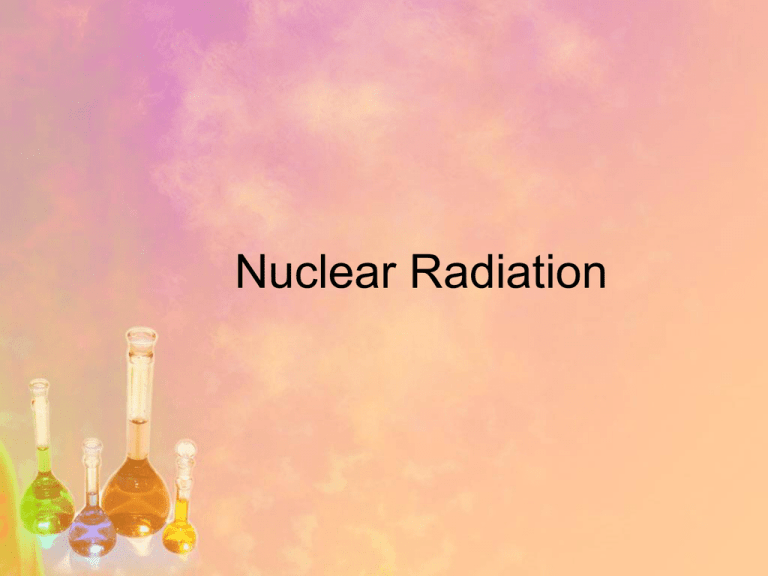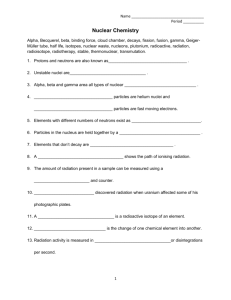Nuclear Radiation
advertisement

Nuclear Radiation Penetrating Ability of Nuclear Radiation Units used to measure radiation exposure • Roentgen – one roentgen is equal to the amount of radiation that produces 2 x 109 ion pairs when it passes through 1 cm3 of dry air • rem – measures radiation damage to tissues; 1 rem equals the quantity of radiation that does as much tissue damage as 1 roentgen of X-Rays • 0.1 rem per year – average background exposure • 0.5 rem per year – maximum permissible dose established by US govt. • 0.05 rem – exposure from a chest x-ray • 0.02 rem – exposure from a dental x-ray Radiation Detection Film badge – relies on ability of radiation to develop photographic film Geiger Counter – measures ionized gases created by nuclear radiation Radioactive Dating • The half life of radioactive nuclides is used to determine the age of objects • Carbon-14 dating is used to determine the age of organic material • C-14 half-life = 5730 years • Other isotopes are used to date older organic material, rocks, minerals, etc. Radioactive tracers • Radioactive isotopes used to measure the movement of substances • Used in medicine to diagnose diseases • Photosynthesis, enzyme activity, use of substances by cells • Movement of groundwater/pollutants Cancer Treatment • Radioactive isotopes kill rapidly growing tumor cells • In some cases, the source is ingested; i.e. Iodine-131 used to treat thyroid cancer • An external source (60Co) can be directed towards the tumor Nuclear Fission • A heavy nucleus splits into smaller-more stable nuclei • Large amount of energy is released Chain reaction Nuclear Power Plants How nuclear energy works – YouTube Fukushima Nuclear Reactor Problem Explained (CNN) - YouTube Nuclear Fusion • Small nuclei combine to form a heavier and more stable nucleus • Large amount of energy is released • Nuclear fusion was once thought to be the ultimate source of energy; • Significant obstacles need to be overcome. What happens to nuclear waste? • Nuclear waste material must be stored safely for hundreds of thousands of years. • Currently, spent fuel rods are stored on-site at nuclear power plants. They are stored in pools of water or eventually in dry casks • Work has been done on a permanent geological storage facility – Yucca mountain, Nevada



